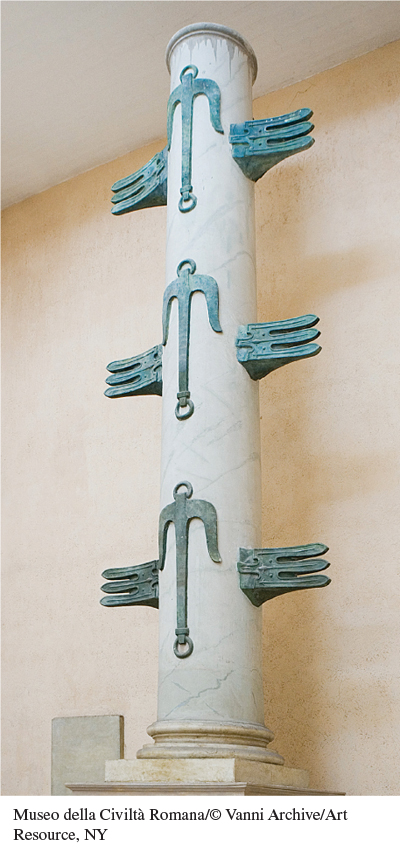A History of Western Society: Printed Page 130
A History of Western Society, Value Edition: Printed Page 124
A History of Western Society, Concise Edition: Printed Page 132
The Punic Wars
As they pushed southward, incorporating the southern Italian peninsula into their growing territory, the Romans confronted another great power in the western Mediterranean, the Carthaginians. The city of Carthage had been founded by Phoenicians as a trading colony in the eighth century B.C.E. (see Chapter 2). It commanded one of the best harbors on the northern African coast and was surrounded by fertile farmland. By the fourth century B.C.E. the Carthaginians began to expand their holdings, and they engaged in war with the Etruscans and with the Greek cities of southern Italy and Sicily. They had one of the largest navies in the Mediterranean and were wealthy enough to hire mercenaries to do much of their fighting. At the end of a long string of wars, the Carthaginians had created and defended a mercantile empire that stretched from western Sicily to the western end of the Mediterranean (see Map 5.1).

Beginning in the fifth century B.C.E. the Romans and the Carthaginians made a series of treaties with one another that defined their spheres of influence, and they worked together in the 270s B.C.E. to defeat Pyrrhus. But the Greek cities that became Roman allies in southern Italy and Sicily, including Syracuse, saw Carthage as a competitor in terms of trade. This competition led to the first of the three Punic Wars between Rome and Carthage. The First Punic War lasted for twenty-
The peace treaty between Rome and Carthage brought no peace, as both powers had their sights set on dominating the western half of the Mediterranean. In 238 B.C.E. the Romans took advantage of Carthaginian weakness to seize Sardinia and Corsica. The Carthaginians responded by expanding their holdings in Spain, under the leadership of the commander Hamilcar Barca. With him he took his ten-
In 221 B.C.E. Hannibal became the Carthaginian commander in Spain and laid siege to Saguntum (suh-
In 210 B.C.E. Rome found its answer to Hannibal in the young commander Scipio Africanus. Scipio copied Hannibal’s methods of mobile warfare and guerrilla tactics and made more extensive use of cavalry than had earlier Roman commanders. In the following years Scipio operated in Spain, which in 207 B.C.E. he wrested from the Carthaginians. That same year the Romans sealed Hannibal’s fate in Italy. At the Battle of Metaurus the Romans destroyed a major Carthaginian army coming to reinforce Hannibal. Scipio then struck directly at Carthage itself, prompting the Carthaginians to recall Hannibal from Italy to defend their homeland.
In 202 B.C.E., at the town of Zama near Carthage (Map 5.2), Scipio defeated Hannibal in a decisive battle. The Carthaginians sued for peace and the Roman Senate agreed, on terms that were very favorable to the Romans. Hannibal himself later served as a military adviser at the Seleucid court in its battle with Rome, and then as an adviser to one of the small kingdoms in Anatolia.
The Second Punic War contained the seeds of still other wars. Unabated fear of Carthage combined with the encouragement of Cato the Elder (see “Opposing Views: Cato the Elder and Scipio Aemilianus”) led to the Third Punic War, a needless, unjust, and savage conflict that ended in 146 B.C.E. when Scipio Aemilianus, the grandson by adoption of Scipio Africanus, destroyed the hated rival and burned Carthage to the ground. Scipio’s friend Polybius, a Greek historian and military leader, later reported that as the Roman conqueror watched the city burn, he said, “I fear and foresee that someday someone will give the same order about my fatherland.”4 It would, however, be centuries before an invader would stand before the gates of Rome.
During the war with Hannibal, the Romans had invaded the Iberian Peninsula, an area rich in material resources and the home of fierce warriors. They met with bloody and determined resistance. Not until 133 B.C.E., after years of brutal and ruthless warfare, did Scipio Aemilianus finally conquer Spain. Scipio’s victory meant that Roman language, law, and culture, fertilized by Greek influences, would in time permeate this entire region, although it would be another century before the Iberian Peninsula was completely pacified.